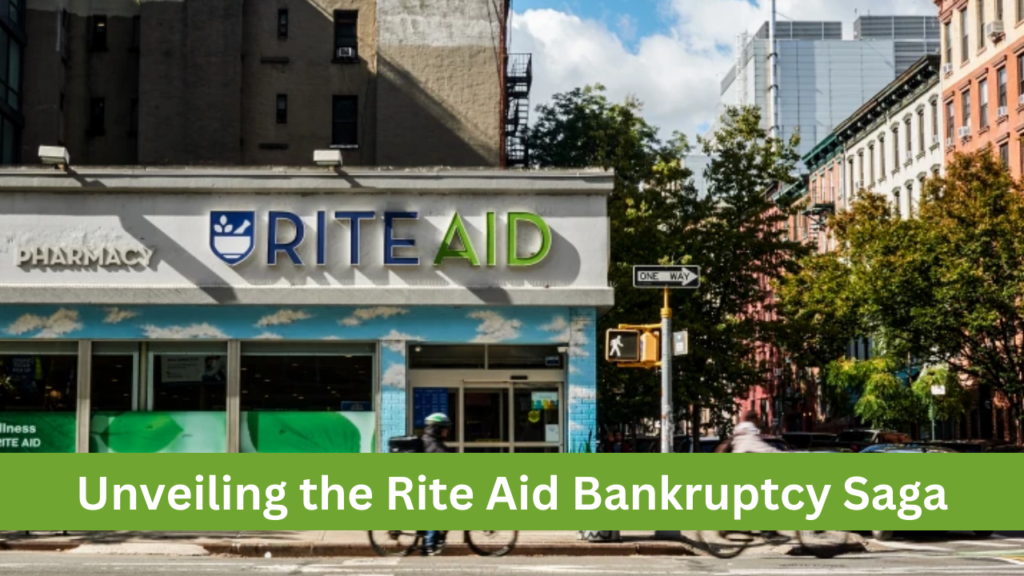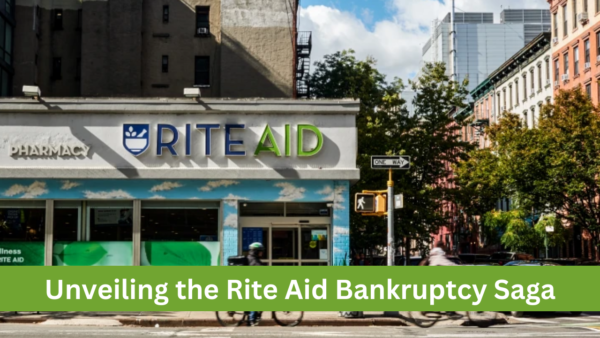The Rite Aid bankruptcy saga, once an unthinkable scenario, has become a startling reality, shaking the foundations of the retail industry. The news of Rite Aid’s financial distress has sent shockwaves through the market, leaving stakeholders and customers bewildered. How did this iconic brand, a symbol of convenience and healthcare accessibility, find itself grappling with the Rite Aid bankruptcy? In this article, we’ll uncover the intricacies of the Rite Aid bankruptcy, exploring the factors responsible for its fall and considering what the future holds for this once-mighty brand.

From Humble Beginnings to a National Giant
Rite Aid, a company born in Scranton, Pennsylvania in 1962, rapidly ascended the ranks of drugstore chains, challenging industry titans such as Walgreens and CVS. With over 2,400 stores spanning the nation, Rite Aid was a trusted name in healthcare convenience.
Nonetheless, the shifting sands of the retail landscape set Rite Aid on a tumultuous journey. The Rite Aid bankruptcy, fueled by fierce competition, changing consumer preferences, and the healthcare industry’s rapid evolution, was exacerbated by a staggering load of debt.
Behind the Rite Aid Bankruptcy Curtain: Exposing the Culprits
The narrative of the Rite Aid bankruptcy is multifaceted, featuring financial mismanagement, misdirected ambitions, and an inability to adapt to a changing world. Here’s a closer look at what led to the Rite Aid bankruptcy:
- Debt Overload: A primary driver behind the Rite Aid bankruptcy was the substantial debt burden. Rite Aid had amassed billions in long-term debt, constricting its capacity to invest in store enhancements, technological upgrades, and employee development. The weight of interest payments gnawed away at profits, constraining the scope for growth amidst the Rite Aid bankruptcy.
- Intense Competition: The Rite Aid bankruptcy was exacerbated by the fierce competition from industry heavyweights like Walgreens and CVS. Endowed with greater resources and market reach, Rite Aid struggled to maintain its competitive edge.
- Changing Consumer Preferences: The Rite Aid bankruptcy narrative was significantly shaped by the shift in consumer behavior, transforming the way people shopped for healthcare and pharmaceutical products. The rise of e-commerce, mail-order prescriptions, and telemedicine services eroded the traditional in-store model, leaving Rite Aid trailing behind.
- Regulatory Challenges: The Rite Aid bankruptcy was further complicated by regulatory hurdles, a shared challenge within the pharmacy sector. These obstacles included rigorous government oversight and the pressure to cut healthcare costs, compounding the strain on pharmacy business profitability during the Rite Aid bankruptcy.
The Human Side of the Rite Aid Bankruptcy
The Rite Aid bankruptcy isn’t just a financial tale; it carries a profound human dimension. Thousands of dedicated Rite Aid employees, with years of commitment, now face uncertain prospects. Communities that depended on their local Rite Aid for healthcare services and prescription medications must adapt to a new reality. For loyal customers, the Rite Aid bankruptcy serves as a harsh reminder of the volatility of the retail world.
A Glimpse of Hope Amidst the Rite Aid Bankruptcy
Despite the somber tone, the Rite Aid bankruptcy doesn’t necessarily spell doom. Rite Aid has initiated Chapter 11 bankruptcy proceedings, offering the possibility of debt restructuring and operational reorganization. This could provide Rite Aid with a fresh start, emerging leaner and better prepared to navigate the challenges of modern retail amidst the Rite Aid bankruptcy.
The Changing Face of Retail Pharmacies During the Rite Aid Bankruptcy
The Rite Aid bankruptcy incident underscores critical questions about the future of retail pharmacies in the United States. With the rise of telemedicine and e-commerce, the role of the neighborhood pharmacy is in flux. While some customers may still prefer the personal touch and convenience of a local pharmacy during the Rite Aid bankruptcy, others may explore digital alternatives. Survival and success for pharmacies facing the Rite Aid bankruptcy may hinge on their capacity to balance tradition and innovation.
A Lesson for All Amidst the Rite Aid Bankruptcy
The Rite Aid bankruptcy serves as a stark reminder that even the most iconic brands can falter if they fail to adapt to changing times. It’s a lesson in financial management, competition, and the ever-evolving nature of consumer behavior. The fate of Rite Aid may still hang in the balance, but its story should serve as a wake-up call for businesses across all industries: adapt or risk becoming a relic of the past.
As Rite Aid navigates the turbulent waters of bankruptcy, its employees, customers, and competitors look on with bated breath, hoping for a revival of the iconic pharmacy chain amidst the Rite Aid bankruptcy, which has been a part of American communities for generations.

